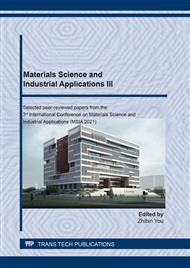p.163
p.172
p.178
p.186
p.195
p.201
p.207
p.213
p.220
Corrosion Inhibition of Brass by Biochemical Process in Circulating Cooling Water System
Abstract:
Controlling the corrosion rate of metal materials is one of the key issues in circulating cooling water treatment. In recent years, the treatment of circulating cooling water by microorganisms has become a research hotspot. Compared with the traditional chemical treatment, microbial treatment is an environmentally friendly technology. In this paper, the effects of ammonia nitrogen concentration, microbial dosage and aeration intensity on copper corrosion rate were studied. In order to analyze the experimental data more comprehensively, a full factor experimental design was used to investigate the effects of ammonia nitrogen concentration, microbial dosage and aeration intensity on copper corrosion. The corrosion rate of copper was less than the national standard (< 0.005 mm / a), in which ammonia nitrogen concentration and aeration intensity were significant factors (P < 0.05), and the interaction between ammonia nitrogen concentration and aeration intensity was also significant (P < 0.05), After optimization, the regression rate of the model increased from 85.02% to 92.41%.
Info:
Periodical:
Pages:
220-225
Citation:
Online since:
May 2021
Authors:
Price:
Сopyright:
© 2021 Trans Tech Publications Ltd. All Rights Reserved
Share:
Citation:


